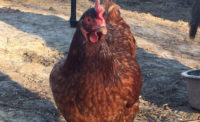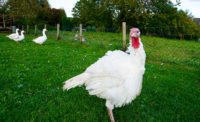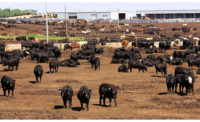Farm to Plate
The importance of feathers in poultry production




When it comes to poultry production, sometimes it is difficult to remember there are a lot of factors that play into why the industry is so successful. Because the major focus of commercial poultry operations has always been on the meat and eggs, we tend to forget about the little things happening behind the scenes that make the difference between a success and a failure. Genetic selection, nutrition, stocking density, well-being, social interactions between birds and many other factors play a role in the production processes; however, the forgotten hero in the mix is feathers and their importance in the production process.
Birds come into the harvesting plant with their feathers intact. Depending on the plant design, a multi-stage process is needed for feathers to be removed. After birds have gone through the exsanguination process, feather removal begins. This includes scalding, which is a hot water bath that loosens the feathers, followed by a rotation through the picker, which rapidly removes the feathers from the skin.
After picking, the feathers are collected, recycled and cleaned before being made into other products, such as feather meal or filling in down pillows. The uses are many and diverse. There are even applications for feathers as a reinforcement in concrete, and dyed feathers may be used for religious ceremonies. To the plant, feathers may seem more of a nuisance rather than a virtue, but they do have value and should be collected as a byproduct.
For the live bird, feathers serve an important physiological function, which is something that is not commonly thought of once the bird reaches the plant. Feathers may be necessary for flight and buoyancy, as seen in waterfowl, or for warmth, which can be seen in just about any species of bird. Feathering is a highly integrated process controlled in birds by complex interactions between the thyroid, gonads, brain and several environmental factors. Feathers are really an extension of the skin tissue, developed as keratinized epithelium derived from specialized follicles in the dermis. In addition, there are different areas on the bird where different feather types grow. Feathers grow in areas called the feather tracts, but there are also areas where feathers do not grow and these areas are called apteria.
Feather development tends to progress in three phases in avian species. First, the natal down are the soft feathers that appear fuzzy on hatchlings. These feathers are important for providing warmth during the first few weeks of life post-hatch when thermoregulatory functions are still developing. Second, the birds produce juvenile feathers, which are the transitional feathers that can last a various length of time depending on the bird’s needs, breed or species. The final phase is the adult feathers. As adults, birds have three types of feathers: plumules, the downy feathers of the abdomen; flioplumes, the hair-like feathers found in apteria areas; and contour feathers, which are located in all other areas on the bird.
At first glance, it is hard to identify why feathers are important to poultry production. When taking into consideration the bird was once a living organism, it is much easier to conclude it needed feathers for one important reason or another. As previously stated, warmth is imperative during early life and is provided by feathers. Birds can alter the position of the feathers to trap air between them to increase surface area and aid in thermoregulation. In addition, molt — both a natural occurring event and a management induced tactic — occurs mainly in egg-laying birds is an important step in production.
Molt is a multi-stage process when egg laying ceases, old feathers are readily shed, and subsequent new feathers are grown. This process is affected by hormonal cascades from the brain, thyroid, ovary and adrenal cortex in laying hens. Several nutritional additives are available, including amino acid supplements, vitamins and ration formulations, to help birds recover faster from molt. But physiological makeup, environmental factors and bird sensitivity to changes, both social and environmental, can restrict how quickly birds will regain their feathers and restart egg production.
In addition, for both meat-type and egg-laying birds, feathers are important for physical protection. In turkeys especially, heavy toms exhibit behavioral changes once they reach sexual maturity and aggressive behaviors increase. Aggressive behaviors may be observed as severe pecking or using its feet to cut another bird. Therefore, maintaining proper feather coverage is necessary, since it aids against these attacks by protecting the skin from assault. Moreover, when birds lose their feathers and need to regrow them, they will be using nutritional resources that may have otherwise been used to increase meat yield. It is a teeter-totter effect on how many feathers a bird may need to grow and the meat composition of the bird.
Feathers are a quick and easy way to determine many physiological attributes that would otherwise require additional testing. For instance, if there is a major component missing in the ration, feather quality and quantity most likely will be decreased. A common issue that can spring up is an amino acid deficiency, which can cause the feathers to develop a concave shape, causing the feathers to bend away from the body.
Although it may seem to be just an annoyance at the processing plant, it is important to remember those feathers served a specific function in the bird’s life. They supplied the bird with warmth and protection against environmental and social implications. Without feathers, the industry as we know it today may not be as successful without this behind-the-scenes player.
So, appreciate the lowly feather. Use it as an indicator of bird health and well-being. Be sure to recycle as much of the bird as possible, including the feathers, since that bird was harvested for our needs. NP
Looking for a reprint of this article?
From high-res PDFs to custom plaques, order your copy today!











